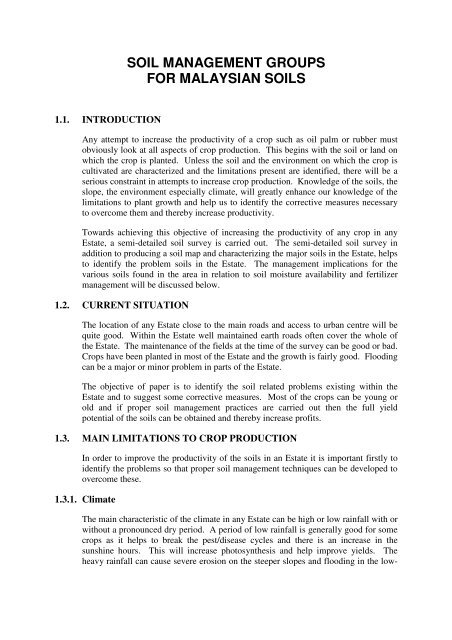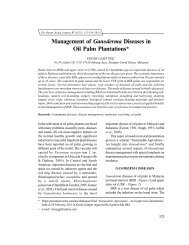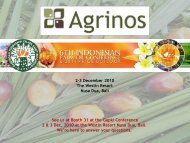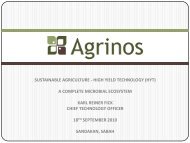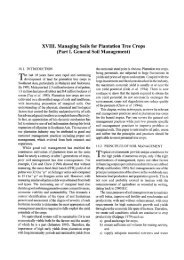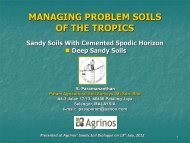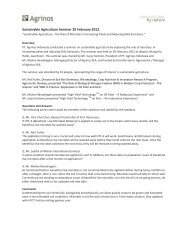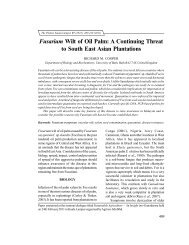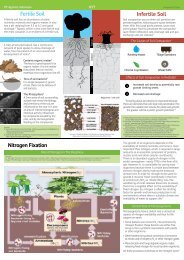SOIL MANAGEMENT GROUPS FOR MALAYSIAN SOILS
SOIL MANAGEMENT GROUPS FOR MALAYSIAN SOILS
SOIL MANAGEMENT GROUPS FOR MALAYSIAN SOILS
Create successful ePaper yourself
Turn your PDF publications into a flip-book with our unique Google optimized e-Paper software.
Soil Management Groups for Malaysian Soils<br />
<strong>SOIL</strong> <strong>MANAGEMENT</strong> <strong>GROUPS</strong><br />
<strong>FOR</strong> <strong>MALAYSIAN</strong> <strong>SOIL</strong>S<br />
1.1. INTRODUCTION<br />
Any attempt to increase the productivity of a crop such as oil palm or rubber must<br />
obviously look at all aspects of crop production. This begins with the soil or land on<br />
which the crop is planted. Unless the soil and the environment on which the crop is<br />
cultivated are characterized and the limitations present are identified, there will be a<br />
serious constraint in attempts to increase crop production. Knowledge of the soils, the<br />
slope, the environment especially climate, will greatly enhance our knowledge of the<br />
limitations to plant growth and help us to identify the corrective measures necessary<br />
to overcome them and thereby increase productivity.<br />
Towards achieving this objective of increasing the productivity of any crop in any<br />
Estate, a semi-detailed soil survey is carried out. The semi-detailed soil survey in<br />
addition to producing a soil map and characterizing the major soils in the Estate, helps<br />
to identify the problem soils in the Estate. The management implications for the<br />
various soils found in the area in relation to soil moisture availability and fertilizer<br />
management will be discussed below.<br />
1.2. CURRENT SITUATION<br />
The location of any Estate close to the main roads and access to urban centre will be<br />
quite good. Within the Estate well maintained earth roads often cover the whole of<br />
the Estate. The maintenance of the fields at the time of the survey can be good or bad.<br />
Crops have been planted in most of the Estate and the growth is fairly good. Flooding<br />
can be a major or minor problem in parts of the Estate.<br />
The objective of paper is to identify the soil related problems existing within the<br />
Estate and to suggest some corrective measures. Most of the crops can be young or<br />
old and if proper soil management practices are carried out then the full yield<br />
potential of the soils can be obtained and thereby increase profits.<br />
1.3. MAIN LIMITATIONS TO CROP PRODUCTION<br />
In order to improve the productivity of the soils in an Estate it is important firstly to<br />
identify the problems so that proper soil management techniques can be developed to<br />
overcome these.<br />
1.3.1. Climate<br />
The main characteristic of the climate in any Estate can be high or low rainfall with or<br />
without a pronounced dry period. A period of low rainfall is generally good for some<br />
crops as it helps to break the pest/disease cycles and there is an increase in the<br />
sunshine hours. This will increase photosynthesis and help improve yields. The<br />
heavy rainfall can cause severe erosion on the steeper slopes and flooding in the low-<br />
1
Soil Management Groups for Malaysian Soils<br />
lying areas. Thus the climate in the Estate can well suited for crop cultivation but can<br />
cause soil erosion and lower yields due to loss of soil fertility.<br />
1.3.2. Topography<br />
The topography of an estate is often an important factor as it determines the runoff<br />
and soil erosion potential of the area. Topography also often determines the type of<br />
roads to be constructed and the method of harvesting used. The terrain in any Estate<br />
can be level/undulating/rolling/hilly/somewhat steep to steep. Thus soil erosion and<br />
runoff can be a problem in parts of the Estate. Due to the steep slopes terracing is<br />
difficult and soil erosion of major concern. Particular attention should be given to<br />
drainage channels and roads so that quick remedial action can be taken when erosion<br />
is noticed.<br />
1.3.3. Flooding<br />
If the topography in parts of the Estate is level, temporary flooding can occur in the<br />
Estate during the rainy seasons. Mature crops of oil palms are quite tolerant of<br />
shallow flooding and moderately high watertables. However deep water conditions or<br />
prolonged flooding, especially if the water is stagnant can kill young palms or retard<br />
the growth of older palms. Flooding can be a minor or major problem in the Estate.<br />
Rubber does not tolerate flooding.<br />
1.3.4. Soil Erosion<br />
Soil erosion and degradation is often a serious problem in the Tropics. This is mainly<br />
because of the intensity of the rainfall. Sandy and loamy soils have the potential to<br />
erode more quickly compared to clayey soils. In addition soils on steeper slopes can<br />
erode more rapidly and severely than soils on the gentler slopes. The potential for<br />
erosion in parts of the Estate can be high if parts of the Estate are on hilly and<br />
somewhat steep slopes and have topsoils that are loamy. Thus if these soils are not<br />
covered quickly then invariably soil erosion will take place. When the soil is exposed<br />
the raindrops not only break-up the soil aggregates, but carries away the clay particles<br />
in suspension leaving the bleached sand grains behind. The erosion that takes place is<br />
not only physical but also chemical as the nutrients are also leached away. In an<br />
effort to minimise soil erosion and loss of soil fertility both terracing and cover crops<br />
have been established. Steps must be taken to monitor and ensure that the soil is<br />
properly covered and that the terraces are well maintained. A potential source of soil<br />
erosion are the roads and drains on the steeper slopes. During the rainy season when<br />
water runs down the slope along the drains and roads, the water picks up momentum<br />
as it runs down the slope and causes rills and gullies to form. To prevent this, silt<br />
traps and breaks should be constructed. All roadcuts should also be covered with<br />
vegetation to prevent landslips. These silt-traps and breaks should be checked<br />
regularly and cleared of debris. The use of oil palm fronds to minimise soil erosion<br />
should be practiced. It is not necessary that the fronds be stacked only in the<br />
interrows but they can be stacked around the palms or on the lips of terraces so as to<br />
break the flow of surface runoff. This method of soil conservation is particularly<br />
important once the crops are bigger and the canopy closes and when the cover crop is<br />
drastically reduced by shading.<br />
2
Soil Management Groups for Malaysian Soils<br />
1.3.5. Soil Fertility<br />
Most tropical soils have a low fertility status. This is mainly a result of the high<br />
temperature and rainfall in these areas resulting in intensive weathering and leaching<br />
leaving the soil impoverished of nutrients. The soils of any Estate can have high,<br />
moderate to low fertility status. Most of the unplanted soils are developed over<br />
igneous/metamorphic or sedimentary rocks. Thus if high yields of crops are to be<br />
obtained then a good dosage of fertilizers are essential. Leaf analysis coupled with<br />
field visits to check on the condition of the palms can be used to monitor the level of<br />
nutrients.<br />
Nitrogen if present is mainly in the organic matter which is generally moderate to low.<br />
The cover crop replaces some of the lost nitrogen but this is not enough and needs to<br />
be supplemented.<br />
Aluminium saturation with its related phosphate fixation is another common problem<br />
in the Tropics. Fortunately crops such as oil palm and rubber can tolerate quite high<br />
aluminium saturation values. The use of cover crops and phosphate fertilizers can<br />
help minimise these problems.<br />
Most other nutrients such as calcium, magnesium and minor elements such as boron,<br />
copper and zinc are also expected to be low to moderate in these soils. These<br />
nutrients can be monitored through leaf analyses and applied as and when necessary.<br />
Thus if the fertility status of the soils in any Estate is low to moderate and hence a<br />
proper fertilization program is essential if high yields of crops are to be obtained and<br />
maintained. The nutrient levels can be monitored using leaf levels.<br />
1.3.6. Soil Fertility Evaluation of the Soils<br />
The fertility status of the soils in the Estate can be assessed using the soil analytical<br />
data available and comparing these with the criteria for oil palm/rubber/cocoa<br />
proposed by Goh et al. (1997). The criteria for oil palm are given in Table 1.1 while<br />
the evaluation using the topsoil and upper subsoil values for the soils sampled for<br />
analyses can be evaluated using Table 1.2 and 1.3.<br />
pH.<br />
Organic carbon.<br />
Nitrogen.<br />
Phosphorus.<br />
Exchangeable Potassium and Magnesium.<br />
Cation Exchange Capacity.<br />
3
Soil Management Groups for Malaysian Soils<br />
Table 1.1. Classification of soil nutrient status for oil palm (Goh et al., 1997).<br />
Status<br />
Parameter<br />
Very low Low Moderate High Very high<br />
pH < 3.5 3.5–4.0 4.0–4.2 4.2–5.5 > 5.5<br />
Organic C (%) < 0.8 0.8–1.2 1.2–1.5 1.5–2.5 > 2.5<br />
Total N (%) < 0.08 0.08–0.12 0.12–0.15 0.15–0.25 > 0.25<br />
Total P (µg g -1 ) < 120 120–200 200–250 250–400 > 400<br />
Available P (µg g -1 ) < 8 8–15 15–20 20–25 > 25<br />
Exchangeable K (cmol kg -1 ) soil < 0.08 0.08–0.20 0.20–0.25 0.25–0.30 > 0.30<br />
Exchangeable Mg (cmol kg -1 ) soil < 0.08 0.08–0.20 0.20–0.25 0.25–0.30 > 0.30<br />
CEC (cmol kg -1 ) soil < 6 6–12 12–15 15–18 > 18<br />
Table 1.2. Soil nutrient status of the soils in _______________ Estate.<br />
Parameter<br />
<strong>SOIL</strong> SERIES<br />
Depth (cm)<br />
pH<br />
Organic C (%)<br />
Total N (%)<br />
Total P (µg g -1 )<br />
Available P (µg g -1 )<br />
Exchangeable K (cmol kg -1 ) soil<br />
Exchangeable Mg (cmol kg -1 ) soil<br />
CEC (cmol kg -1 ) soil<br />
Table 1.3. Evaluation of soil fertility status of the soils in _______________ Estate.<br />
Parameter<br />
<strong>SOIL</strong> SERIES<br />
Depth (cm)<br />
pH<br />
Organic C (%)<br />
Total N (%)<br />
Total P (µg g -1 )<br />
Available P (µg g -1 )<br />
Exchangeable K (cmol kg -1 ) soil<br />
Exchangeable Mg (cmol kg -1 ) soil<br />
CEC (cmol kg -1 ) soil<br />
nd = not determined PASS – March 2010<br />
tr = trace<br />
4
Soil Management Groups for Malaysian Soils<br />
1.4. MINERAL <strong>SOIL</strong> <strong>MANAGEMENT</strong> <strong>GROUPS</strong><br />
The soil survey carried out in an Estate can identify a number of different soil<br />
mapping units of which most soil units have been planted. Some of these units are<br />
not very extensive while others are more extensive. However in order to manage the<br />
Estate efficiently, these soil mapping units planted with crops can be grouped to form<br />
soil management groups. Each management group will consist of soils for which a<br />
set of management practices can be applied. A number of ______ soil management<br />
groups can be identified in the Estate. These are then summarised in Table 1.4 and<br />
discussed below.<br />
1.4.1. Soil Management Group A<br />
Soil Management Group A consists of deep (>100 cm) to moderately deep (50-100<br />
cm), well drained soils. These soils have a sandy clay, sandy clay loam topsoil that<br />
grade to a sandy clay (>35% clay) in the subsoils. These soils can occur on level,<br />
undulating, rolling, hilly, somewhat steep and steep terrain. Thus the moderate to low<br />
soil fertility status and soil erosion are the main problems of the soils in this Group.<br />
Thus the management of these soils requires measures such as fertilization. Soil<br />
erosion monitoring and mitigation measures need to be taken particularly on the<br />
steeper terrain. These include terracing, cover crop establishment and frond stacking.<br />
Where coarse sand dominates the soil, erosion potential is high.<br />
1.4.2. Soil Management Group B<br />
Soil Management Group B consists of moderately deep (50-100 cm) to deep (>100<br />
cm), well to moderately well drained soils with sandy clay loam (18-35%) subsoils<br />
and sandy loam to sandy clay loam topsoils. Most of these soils are developed over<br />
sedimentary rocks and sub-recent alluvium and can occur on level, undulating, rolling<br />
to hilly and somewhat steep to steep terrain. These soils have a low to moderate<br />
fertility status. Soil erosion and soil depth can also be a problem. Thus the<br />
management of these soils requires proper fertilization. Soil erosion monitoring and<br />
mitigation needs to be carried out. Soil conservation measures include terracing,<br />
cover crop establishment and frond stacking.<br />
1.4.3. Soil Management Group C<br />
Soil Management Group C consists of imperfectly, poorly and very poorly drained<br />
sandy clay to sandy clay loam textured soils. These soils can occur on level to gently<br />
undulating terrain. These soils have an imperfect to poor drainage and a low fertility<br />
status. The management of these soils requires drainage, flood mitigation and proper<br />
fertilization with special emphasis on P and K.<br />
5
Soil Management Groups for Malaysian Soils<br />
Table 1.4. Soil Management Groups.<br />
Soil<br />
Management<br />
Group<br />
Soil<br />
Map<br />
Units<br />
Main<br />
Characteristic/<br />
Limitation<br />
Peak Yield<br />
Management<br />
Extent<br />
Potential<br />
Practices<br />
Needed mt/ha/yr Ha %<br />
A<br />
B<br />
C<br />
D<br />
E<br />
F<br />
Deep (>100 cm) to<br />
moderately deep (50-100<br />
cm) fine sandy clay to<br />
clay (>35% clay) textured<br />
soils. Soil erosion on<br />
steeper slopes.<br />
Low fertility.<br />
Deep (>100 cm) to<br />
moderately deep (50-100<br />
cm) well drained soils.<br />
Texture sandy clay loam<br />
(18-35% clay). Moisture<br />
stress and yield<br />
fluctuations.<br />
Soil erosion on steeper<br />
slopes.<br />
Low fertility.<br />
Deep (>100 cm),<br />
imperfect to poorly<br />
drained alluvial soils.<br />
Textures clay to sandy<br />
clay to sandy clay loam.<br />
Flooding and high water<br />
tables.<br />
Low fertility status.<br />
Shallow (100 cm)<br />
sandy (
Soil Management Groups for Malaysian Soils<br />
Table 1.4. Soil Management Groups (cont’d).<br />
Soil<br />
Management<br />
Group<br />
Soil<br />
Map<br />
Units<br />
Main<br />
Characteristic/<br />
Limitation<br />
Peak Yield<br />
Management<br />
Extent<br />
Potential<br />
Practices<br />
Needed mt/ha/yr Ha %<br />
G<br />
H<br />
I<br />
J<br />
K<br />
L<br />
NAL<br />
Shallow (
Soil Management Groups for Malaysian Soils<br />
1.4.4. Soil Management Group D<br />
Soil Management Group D consists of shallow (100 cm) sands and sandy podzols. The shallow (100 cm) soils are excessively drained with sandy textures.<br />
Thus low moisture and nutrient holding capacity and erosion and leaching losses are<br />
the main problems. Where strongly cemented spodic horizons occur within 50 cm,<br />
seasonal flooding can be a problem. This requires the spodic horizon to be broken.<br />
On the deep sandy soils, lack of moisture and low fertility are a serious problem. EFB<br />
or organic mulching is essential on these soils. Extra dosages of fertilizers using split<br />
applications would be beneficial.<br />
1.4.5. Soil Management Group E<br />
Soil Management Group E consists of shallow (50-100 cm)/moderately deep (100-<br />
150 cm)/deep (150-300 cm)/very deep (>300 cm) organic soils. These very poorly<br />
drained soils when drained and cultivated have problems of leaning palms, poor<br />
drainage and flooding coupled with complex nutritional problems. Trace elements are<br />
also a problem. The management of these soils involves controlled drainage and<br />
flood mitigation. Proper fertilization and trace element application are essential.<br />
Yields after about 12-15 years often decline.<br />
1.4.6. Soil Management Group F<br />
Soil Management Group F consists of shallow (
Soil Management Groups for Malaysian Soils<br />
1.4.9. Soil Management Group I<br />
Soil Management Group I consists of poorly drained silty clay to clay textured soils<br />
developed over marine and estuarine clays. These soils can have an acid sulfate layer<br />
below 50 cm depths. The management of these soils requires controlled drainage,<br />
flood mitigation and proper fertilization with special emphasis on K.<br />
1.4.10. Soil Management Group J<br />
Soil Management Group J consists of true acid sulfate soils where the jarosite layer<br />
occurs within 50 cm of the soil surface. These poorly drained soils are developed<br />
over sulfidic marine clays or brackish water deposits. They are often silty-clay to clay<br />
textured. Their main limitation is their acidic nature which causes nutrient uptake<br />
problems and toxicity to roots. The management of these soils requires controlled<br />
drainage to maintain watertables around 60-80 cm depth. This is done by the use of<br />
tidal gates, weirs etc. and periodic flushing in the rainy season and the retention of<br />
water in the drains in the dry season. Potassium levels in these soils needs to be<br />
monitored and bunch ash or prudent EFB applications can be useful. Liming is<br />
generally not recommended.<br />
1.4.11. Soil Management Group K<br />
Soils in this Group are unripe and undrained potential acid sulfate soils developed<br />
over marine, estuarine or brackish water deposits. Currently these soils can be saline<br />
and cannot be planted unless drained. On drainage these soils can develop into Soil<br />
Management Groups I or J.<br />
1.4.12. Soil Management Group L<br />
Soil Management Group L consists of moderately deep (50-100 cm) to deep (>100<br />
cm) well to moderately well drained soils with sandy loam (10-18% clay) subsoils.<br />
They can occur on level to steep terrain depending on the parent material from which<br />
they develop. These soils are highly erodable, have low nutrient and moisture<br />
retention capacity and very low fertility status. Consequently yield fluctuations are<br />
common. The management requires moisture conservation, additional fertilization<br />
and soil conservation.<br />
1.5. ORGANIC <strong>SOIL</strong> <strong>MANAGEMENT</strong> <strong>GROUPS</strong><br />
1.5.1. Soil Management Group Oa<br />
Soil Management Group Oa consists of shallow (50-100 cm) to moderately deep<br />
(100-150 cm), deep (150-300 cm), very deep (>300 cm) organic soils with sapric<br />
materials and no wood to 100 cm (e.g. Erong and Liku Series). These very poorly<br />
drained soils when drained and cultivated have problems of leaning palms, poor<br />
drainage and flooding coupled with complex nutritional problems. Trace elements are<br />
also a problem. The management of these soils involves controlled drainage and<br />
flood mitigation. Proper fertilization and trace element application are essential.<br />
Yields after about 12-15 years often tend to decline.<br />
9
Soil Management Groups for Malaysian Soils<br />
Soil<br />
Management<br />
Group<br />
Oa<br />
Oawd<br />
Oawu<br />
Oe<br />
Oewd<br />
Oewu<br />
Soil<br />
Map<br />
Units<br />
Table 1.5. Peat soil management groups map legend.<br />
Main<br />
Characteristic/<br />
Limitation<br />
Shallow (50-100 cm),<br />
moderately deep (100-150<br />
cm), deep (150-300 cm) to<br />
very deep (300+ cm) sapric<br />
material, non-woody.<br />
Poorly drained. Low<br />
fertility.<br />
Shallow (50-100 cm),<br />
moderately deep (100-150<br />
cm), deep (150-300 cm) to<br />
very deep (300+ cm) sapric<br />
material with decomposed<br />
wood. Poorly drained.<br />
Stunted growth common<br />
after five years. Termites.<br />
Low fertility.<br />
Shallow (50-100 cm),<br />
moderately deep (100-150<br />
cm), deep (150-300 cm) to<br />
very deep (300+ cm) sapric<br />
material with<br />
undecomposed wood.<br />
Poorly drained. Stunted<br />
growth common after five<br />
years. Termites. Low<br />
fertility. High cost of drain<br />
construction.<br />
Shallow (50-100 cm),<br />
moderately deep (100-150<br />
cm), deep (150-300 cm) to<br />
very deep (300+ cm) hemic<br />
material, non-woody.<br />
Poorly drained. Low<br />
fertility.<br />
Shallow (50-100 cm),<br />
moderately deep (100-150<br />
cm), deep (150-300 cm) to<br />
very deep (300+ cm) hemic<br />
material with decomposed<br />
wood. Poorly drained .<br />
Stunted growth common<br />
after five years. Termites.<br />
Low fertility. Moderate<br />
drain construction costs.<br />
Shallow (50-100 cm),<br />
moderately deep (100-150<br />
cm), deep (150-300 cm) to<br />
very deep (300+ cm) hemic<br />
material with<br />
undecomposed wood.<br />
Poorly drained . Stunted<br />
growth common after five<br />
years. Termites. Low<br />
fertility. High cost of drain<br />
construction.<br />
Management<br />
Practices<br />
Needed<br />
Compaction of planting<br />
rows.<br />
High planting density.<br />
Water control and<br />
management.<br />
Good fertilizer programme<br />
with Cu, B and Zn.<br />
Compaction of planting<br />
rows.<br />
High planting density.<br />
Water control and<br />
management.<br />
Good fertilizer programme<br />
with Cu, B, Zn.<br />
Thinning of stunted palms.<br />
Compaction of planting<br />
rows.<br />
High planting density.<br />
Water control and<br />
management.<br />
Good fertilizer programme<br />
with Cu, B, Zn.<br />
Thinning of stunted palms.<br />
Compaction of planting<br />
rows.<br />
High planting density.<br />
Water control and<br />
management.<br />
Good fertilizer programme<br />
with Cu, B and Zn.<br />
Compaction of planting<br />
rows.<br />
High planting density.<br />
Water control and<br />
management.<br />
Good fertilizer programme<br />
with Cu, B, Zn.<br />
Thinning of stunted palms.<br />
Compaction of planting<br />
rows.<br />
High planting density.<br />
Water control and<br />
management.<br />
Good fertilizer programme<br />
with Cu, B, Zn.<br />
Thinning of stunted palms.<br />
Peak<br />
Yield<br />
Potential<br />
Extent<br />
mt/ha/yr Ha %<br />
26-28<br />
24-26<br />
22-24<br />
24-26<br />
22-24<br />
20-22<br />
10
Soil Management Groups for Malaysian Soils<br />
Soil<br />
Management<br />
Group<br />
Oi<br />
Oiwd<br />
Oiwu<br />
Table 1.5. Peat soil management groups map legend (cont’d).<br />
Soil<br />
Map<br />
Units<br />
Main<br />
Characteristic/<br />
Limitation<br />
Shallow (50-100 cm),<br />
moderately deep (100-150<br />
cm), deep (150-300 cm) to<br />
very deep (300+ cm) fibric<br />
material, non-woody.<br />
Poorly drained. Low<br />
fertility.<br />
Shallow (50-100 cm),<br />
moderately deep (100-150<br />
cm), deep (150-300 cm) to<br />
very deep (300+ cm) fibric<br />
material with decomposed<br />
wood. Poorly drained.<br />
Stunted growth common<br />
after five years. Termites.<br />
Low fertility. High cost of<br />
drain construction.<br />
Shallow (50-100 cm),<br />
moderately deep (100-150<br />
cm), deep (150-300 cm) to<br />
very deep (300+ cm) fibric<br />
material with<br />
undecomposed wood.<br />
Poorly drained. Low bulk<br />
density. Stunted growth<br />
common after five years.<br />
Termites. Low fertility.<br />
High cost of drain<br />
construction.<br />
Management<br />
Practices<br />
Needed<br />
Compaction of planting<br />
rows.<br />
High planting density.<br />
Water control and<br />
management.<br />
Good fertilizer programme<br />
with Cu, B and Zn.<br />
Compaction of planting<br />
rows.<br />
High planting density.<br />
Water control and<br />
management.<br />
Good fertilizer programme<br />
with Cu, B, Zn.<br />
Thinning of stunted palms.<br />
Compaction of planting<br />
rows.<br />
High planting density.<br />
Water control and<br />
management.<br />
Good fertilizer programme<br />
with Cu, B, Zn.<br />
Thinning of stunted palms.<br />
Peak<br />
Yield<br />
Potential<br />
Extent<br />
mt/ha/yr Ha %<br />
22-24<br />
20-22<br />
18-20<br />
1.5.2. Soil Management Group Oawd<br />
Soil Management Group Oawd consists of shallow (50-100 cm), moderately deep<br />
(100-150 cm) and deep (150-300 cm) organic soils with sapric materials in the subsurface<br />
tier (50-100 cm) together with decomposed wood (e.g. Kabala and Kabok<br />
Series). These very poorly drained soils when drained and cultivated present<br />
problems such as leaning palms, poor drainage and flooding coupled with complex<br />
nutritional problems. Trace elements are also a problem. The presence of wood can<br />
cause desiccation of palms 5 years after planting if these palms have been planted<br />
over or close to old stumps or buried wood/logs as root development becomes poor.<br />
Termite activity can also cause problems. The management of these soils involves<br />
controlled drainage and flood mitigation and constant monitoring for termites and<br />
stunted palms. Proper fertilization and trace element application are essential. Yields<br />
tend to decline 12-15 years after planting.<br />
1.5.3. Soil Management Group Oawu<br />
Soil Management Group Oawu consists of very deep (>300 cm) organic soils with<br />
sapric materials in the sub-surface tier (50-100 cm) together with undecomposed<br />
wood (e.g. Karap Series). These very poorly drained soils when drained and<br />
11
Soil Management Groups for Malaysian Soils<br />
cultivated present some problems such as leaning palms, poor drainage and flooding<br />
coupled with complex nutritional problems. Trace elements are also a problem. The<br />
presence of wood can cause desiccation of palms 5 years after planting if these palms<br />
have been planted over or close to old stumps or buried wood/logs as root<br />
development becomes poor. Termite activity can also cause problems. The<br />
management of these soils involves controlled drainage and flood mitigation and<br />
constant monitoring for termites and stunted palms. Proper fertilization and trace<br />
element application are essential. Yields tend to decline 12-15 years after planting<br />
1.5.4. Soil Management Group Oe<br />
Soil Management Group Oe consists of shallow (50-100 cm) to moderately deep<br />
(100-150 cm), deep (150-300 cm), very deep (>300 cm) organic soils with hemic<br />
materials and no wood to 100 cm (Non-identified yet). These very poorly drained<br />
soils when drained and cultivated have problems of leaning palms, poor drainage and<br />
flooding coupled with complex nutritional problems. Trace elements are also a<br />
problem. The management of these soils involves controlled drainage and flood<br />
mitigation. Proper fertilization and trace element application are essential. Yields<br />
after about 12-15 years often decline.<br />
1.5.5. Soil Management Group Oewd<br />
Soil Management Groups Oewd consist of very deep (>300 cm) organic soils with<br />
hemic materials in the sub-surface tier (50-100 cm) together with decomposed wood<br />
(e.g. Gali, Adong and Gondang Series). These very poorly drained soils when<br />
drained and cultivated present some problems such as leaning palms, poor drainage<br />
and flooding coupled with complex nutritional problems. Trace elements are also a<br />
problem. The presence of decomposed wood can cause increase in the cost of drain<br />
construction and often results in desiccation of palm 5 years after planting if these<br />
palms have been planted over or close to old stumps or buried wood/logs as root<br />
development becomes poor. Termite activity can also cause problems. The<br />
management of these soils involves controlled drainage and flood mitigation and<br />
constant monitoring for termites and stunted palms. Proper fertilization and trace<br />
element application are essential. Yields tend to decline 12-15 years after planting.<br />
1.5.6. Soil Management Group Oewu<br />
Soil Management Group Oewu consists of shallow (50-100 cm), moderately deep<br />
(100-150 cm), deep (150-300 cm) and very deep (>300 cm) organic soils with hemic<br />
materials in the sub-surface tier (50-100 cm) together with undecomposed wood (e.g.<br />
Alan and Taniku Series). These very poorly drained soils when drained and<br />
cultivated present some problems such as leaning palms, poor drainage and flooding<br />
coupled with complex nutritional problems. Trace elements are also a problem. The<br />
presence of undecomposed wood can result in higher costs of drain construction and<br />
can cause desiccation of palm 5 years after planting if these palms have been planted<br />
over or close to old stumps or buried wood/logs as root development becomes poor.<br />
Termite activity can also cause problems. The management of these soils involves<br />
controlled drainage and flood mitigation and constant monitoring for termites and<br />
stunted palms. Proper fertilization and trace element application are essential. Yields<br />
tend to decline 12-15 years after planting.<br />
12
Soil Management Groups for Malaysian Soils<br />
1.5.7. Soil Management Group Oi<br />
Soil Management Group Oi consists of shallow (50-100 cm) to moderately deep (100-<br />
150 cm), deep (150-300cm), very deep (>300cm) organic soils with fibric materials<br />
and no wood to 100 cm (e.g. Changkat Lobak and Arang Series). These very poorly<br />
drained soils when drained and cultivated have problems of leaning palms, poor<br />
drainage and flooding coupled with complex nutritional problems. Trace elements are<br />
also a problem. The management of these soils involves controlled drainage and<br />
flood mitigation. Proper fertilization and trace element application are essential.<br />
Yields after about 12-15 years often decline.<br />
1.5.8. Soil Management Group Oiwd<br />
Soil Management Group Oiwd consists of shallow (50-100 cm), moderately deep<br />
(100-150 cm), deep (150-300 cm) and very deep (>300 cm) organic soils with fibric<br />
materials in the sub-surface tier (50-100 cm) together with decomposed wood (e.g.<br />
Klias and Salleh Series). These very poorly drained soils when drained and cultivated<br />
present some problems such as leaning palms, poor drainage and flooding coupled<br />
with complex nutritional problems. Trace elements are also a problem. The presence<br />
of the decomposed wood increases slightly the cost of drain construction and can<br />
cause desiccation of palm 5 years after planting if these palms have been planted over<br />
or close to old stumps or buried wood/logs as root development becomes poor.<br />
Termite activity can also cause problems. The management of these soils involves<br />
controlled drainage and flood mitigation and constant monitoring for termites and<br />
stunted palms. Proper fertilization and trace element application are essential. Yields<br />
tend to decline 12-15 years after planting.<br />
1.5.9. Soil Management Group Oiwu<br />
Soil Management Group Oiwu consists of shallow (50-100 cm), moderately deep<br />
(100-150 cm), deep (150-300 cm) and very deep (>300 cm) organic soils with fibric<br />
materials in the sub-surface tier (50-100 cm) together with undecomposed wood (e.g.<br />
Anderson and Tinjar Series). These very poorly drained soils when drained and<br />
cultivated present some problems such as leaning palms, poor drainage and flooding<br />
coupled with complex nutritional problems. Trace elements are also a problem. The<br />
presence of undecomposed wood can significantly increase the cost of drain<br />
construction and cause desiccation of palm 5 years after planting if these palms have<br />
been planted over or close to old stumps or buried wood/logs as root development<br />
becomes poor. Termite activity can also cause problems. The management of these<br />
soils involves controlled drainage and flood mitigation and constant monitoring for<br />
termites and stunted palms. Proper fertilization and trace element application are<br />
essential. Yields tend to decline 12-15 years after planting.<br />
1.6. OVERALL YIELD POTENTIAL<br />
The Estate/Plantation often would have already put into practice many of the<br />
recommended practices. Crops often have been well established and maintained.<br />
These need to be regularly examined and quick remedial measures taken to correct<br />
any slope failure and soil erosion. Regular fertilization is often practiced but this can<br />
be further fine tuned using the soil map and with the use of foliar analysis and field<br />
visits by agronomists. When all of these measures are practiced then an overall yield<br />
13
Soil Management Groups for Malaysian Soils<br />
in the range of 28-32 mt/ha/yr and 26-30 mt/ha/yr should be obtainable on the better<br />
soils of Management Groups A and B respectively. In the case of the imperfectly to<br />
poorly drained soils of Management Group C a yield potential of 28-34 mt/ha/yr are<br />
obtainable with good management. The sandy soils of Group D can, with good<br />
management, give yields of 18-24 mt/ha/yr but large inputs are required. On the<br />
poorer organic soils of Management Group E a yield of 24-28 mt/ha/yr should be<br />
obtainable but water management is essential. On the shallow soils of Group F a<br />
yield of 24-28 mt/ha/yr are obtainable. On the shallow lateritic soils of the Group G<br />
yield variation with rainfall can be expected. A yield of 22-28 mt/ha/yr is possible<br />
depending on rainfall distribution and management. On the limestone soils of Group<br />
H a yield of 22-26 mt/ha/yr are obtainable. On the coastal marine/estuarine clay or<br />
silty clay soils of Group I with good water management a yield potential of 28-34<br />
mt/ha/yr should be possible. On the true acid sulfate soils of Group J and the drained<br />
potential acid sulfate soils of Group K a yield potential of 24-32 mt/ha/yr is possible<br />
depending on water management and optimum fertilizer applications.<br />
In the case of the organic soil Groups, the yield potential would depend on the nature<br />
of the organic soil materials, the presence/absence of wood and whether the wood id<br />
decomposed or undecomposed. The depth of the organic soils may also influence the<br />
yield (see Table 1.5).<br />
14


